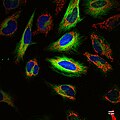Preclinical imaging
Preclinical imaging is a branch of medical imaging that involves the visualization of living organisms for research purposes. It is a vital tool in biomedical research, allowing scientists to observe changes in an organism's structure and function over time, without the need for invasive procedures.
Overview[edit]
Preclinical imaging is used in various fields of research, including oncology, cardiology, neurology, and infectious diseases. It allows researchers to monitor disease progression, assess the efficacy of therapeutic interventions, and understand the pathophysiology of diseases at a molecular level.
Types of Preclinical Imaging[edit]
There are several types of preclinical imaging techniques, each with its own strengths and limitations. These include:
- Magnetic Resonance Imaging (MRI): This technique uses a strong magnetic field and radio waves to create detailed images of the inside of the body. It is particularly useful for imaging soft tissues and organs.
- Computed Tomography (CT): CT scans use X-rays to create cross-sectional images of the body. This technique is often used to image bone and blood vessels.
- Positron Emission Tomography (PET): PET scans use a radioactive tracer to show how tissues and organs are functioning. This technique is often used in oncology research.
- Single Photon Emission Computed Tomography (SPECT): Like PET, SPECT also uses a radioactive tracer. However, it provides a 3D image and is often used to image the brain and heart.
- Ultrasound: This technique uses sound waves to create images of the inside of the body. It is often used for imaging the heart and blood vessels.
Applications[edit]
Preclinical imaging is used in a wide range of research applications. These include:
- Drug Development: Preclinical imaging can be used to assess the efficacy of new drugs and therapies. It can also be used to monitor the distribution of drugs within the body.
- Disease Modeling: Preclinical imaging can be used to create models of diseases, allowing researchers to study their progression and develop new treatments.
- Biomarker Discovery: Preclinical imaging can be used to identify new biomarkers for diseases. These biomarkers can then be used for early detection and treatment.
See Also[edit]
|
|
|
-
Molecubes SPECT uCT and PET
-
7T cryogen free preclinical MRI System - MRS 7000 series
-
Micro-CT
-
VolRender Shear Warp
-
High resolution mouse bone SPECT scan
-
3T sequential PET-MR with 10cm bore diameter at Michigan
-
Image shows the MRI system with clip-on SPECT
-
Multicolor fluorescence image of living HeLa cells
Ad. Transform your life with W8MD's Budget GLP-1 injections from $75


W8MD offers a medical weight loss program to lose weight in Philadelphia. Our physician-supervised medical weight loss provides:
- Weight loss injections in NYC (generic and brand names):
- Zepbound / Mounjaro, Wegovy / Ozempic, Saxenda
- Most insurances accepted or discounted self-pay rates. We will obtain insurance prior authorizations if needed.
- Generic GLP1 weight loss injections from $75 for the starting dose.
- Also offer prescription weight loss medications including Phentermine, Qsymia, Diethylpropion, Contrave etc.
NYC weight loss doctor appointmentsNYC weight loss doctor appointments
Start your NYC weight loss journey today at our NYC medical weight loss and Philadelphia medical weight loss clinics.
- Call 718-946-5500 to lose weight in NYC or for medical weight loss in Philadelphia 215-676-2334.
- Tags:NYC medical weight loss, Philadelphia lose weight Zepbound NYC, Budget GLP1 weight loss injections, Wegovy Philadelphia, Wegovy NYC, Philadelphia medical weight loss, Brookly weight loss and Wegovy NYC
|
WikiMD's Wellness Encyclopedia |
| Let Food Be Thy Medicine Medicine Thy Food - Hippocrates |
Medical Disclaimer: WikiMD is not a substitute for professional medical advice. The information on WikiMD is provided as an information resource only, may be incorrect, outdated or misleading, and is not to be used or relied on for any diagnostic or treatment purposes. Please consult your health care provider before making any healthcare decisions or for guidance about a specific medical condition. WikiMD expressly disclaims responsibility, and shall have no liability, for any damages, loss, injury, or liability whatsoever suffered as a result of your reliance on the information contained in this site. By visiting this site you agree to the foregoing terms and conditions, which may from time to time be changed or supplemented by WikiMD. If you do not agree to the foregoing terms and conditions, you should not enter or use this site. See full disclaimer.
Credits:Most images are courtesy of Wikimedia commons, and templates, categories Wikipedia, licensed under CC BY SA or similar.
Translate this page: - East Asian
中文,
日本,
한국어,
South Asian
हिन्दी,
தமிழ்,
తెలుగు,
Urdu,
ಕನ್ನಡ,
Southeast Asian
Indonesian,
Vietnamese,
Thai,
မြန်မာဘာသာ,
বাংলা
European
español,
Deutsch,
français,
Greek,
português do Brasil,
polski,
română,
русский,
Nederlands,
norsk,
svenska,
suomi,
Italian
Middle Eastern & African
عربى,
Turkish,
Persian,
Hebrew,
Afrikaans,
isiZulu,
Kiswahili,
Other
Bulgarian,
Hungarian,
Czech,
Swedish,
മലയാളം,
मराठी,
ਪੰਜਾਬੀ,
ગુજરાતી,
Portuguese,
Ukrainian









